Business Continuity Plan and Disaster Recovery: Malware Evasion Report
VerifiedAdded on 2020/04/21
|5
|836
|345
Report
AI Summary
This report provides an overview of various malware evasion techniques employed by developers to bypass detection systems. It discusses obfuscation, string manipulation, stealth malware, and encrypted malware as key methods. The report highlights the importance of malware detection and protection, especially in smart devices, and emphasizes the challenges faced by antivirus vendors. It also differentiates between static and dynamic analysis techniques used to analyze malware. The report concludes by acknowledging the ongoing race between malware authors and automated threat analysis systems, underscoring the need for continuous research and advancements in detection methods to combat cyber threats. References to relevant research papers are included.
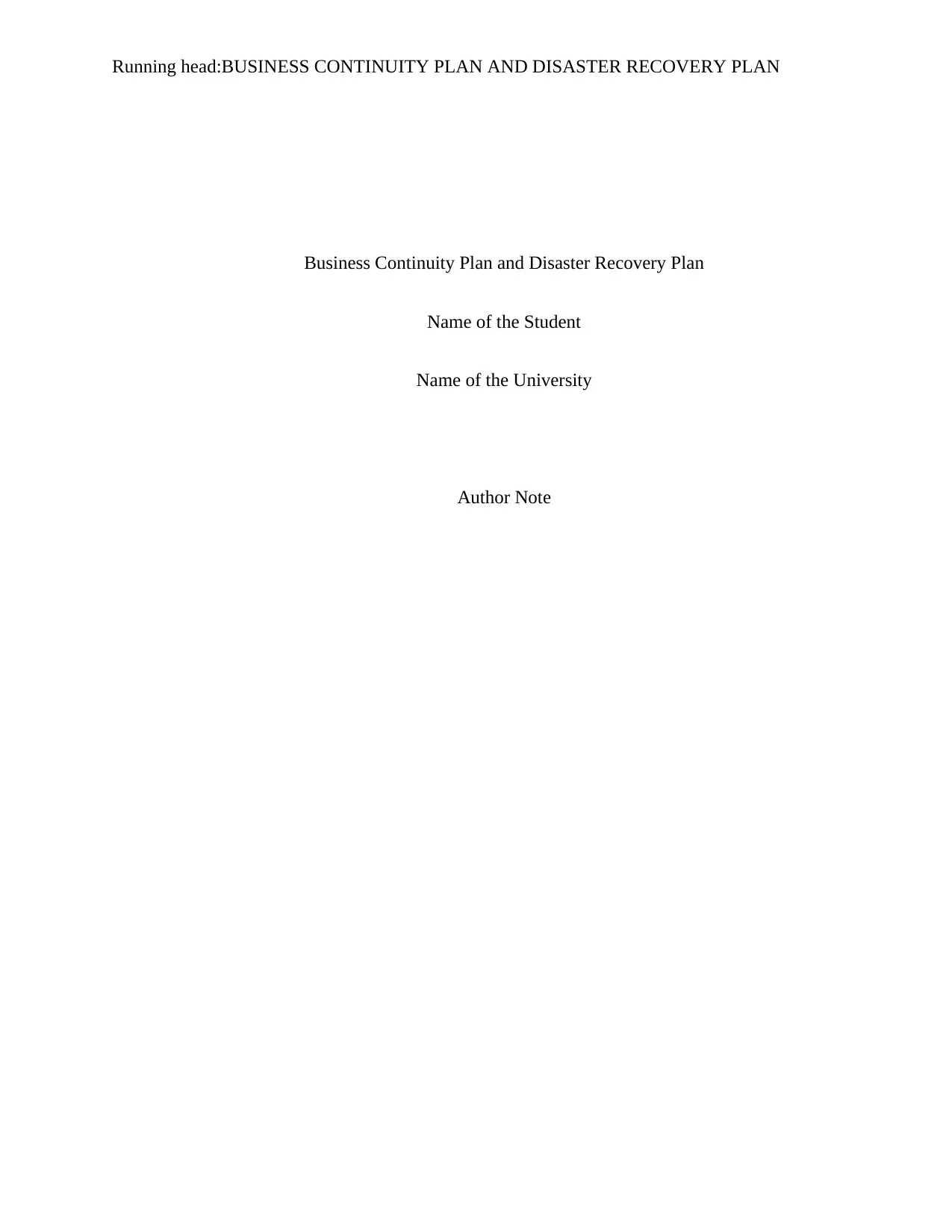
Running head:BUSINESS CONTINUITY PLAN AND DISASTER RECOVERY PLAN
Business Continuity Plan and Disaster Recovery Plan
Name of the Student
Name of the University
Author Note
Business Continuity Plan and Disaster Recovery Plan
Name of the Student
Name of the University
Author Note
Paraphrase This Document
Need a fresh take? Get an instant paraphrase of this document with our AI Paraphraser
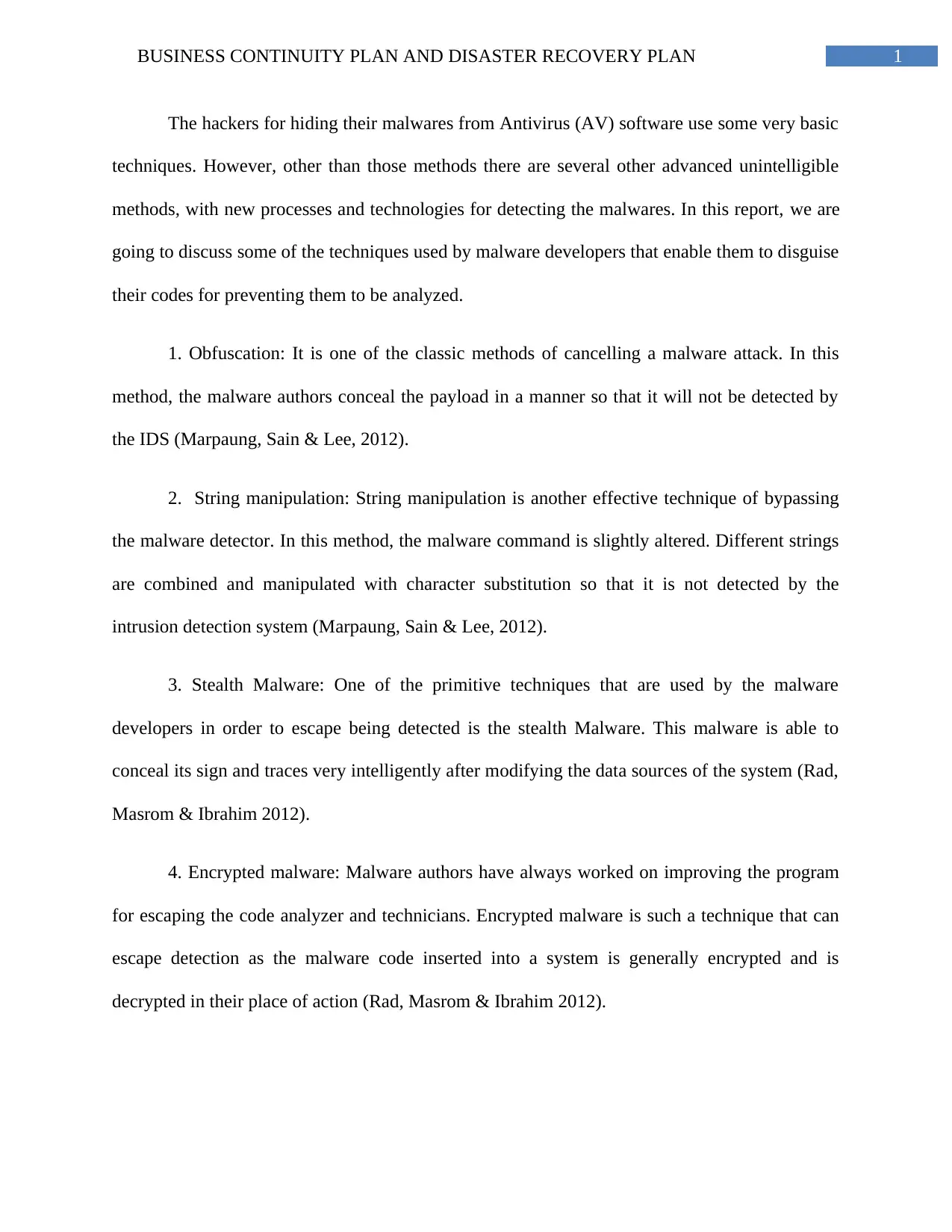
1BUSINESS CONTINUITY PLAN AND DISASTER RECOVERY PLAN
The hackers for hiding their malwares from Antivirus (AV) software use some very basic
techniques. However, other than those methods there are several other advanced unintelligible
methods, with new processes and technologies for detecting the malwares. In this report, we are
going to discuss some of the techniques used by malware developers that enable them to disguise
their codes for preventing them to be analyzed.
1. Obfuscation: It is one of the classic methods of cancelling a malware attack. In this
method, the malware authors conceal the payload in a manner so that it will not be detected by
the IDS (Marpaung, Sain & Lee, 2012).
2. String manipulation: String manipulation is another effective technique of bypassing
the malware detector. In this method, the malware command is slightly altered. Different strings
are combined and manipulated with character substitution so that it is not detected by the
intrusion detection system (Marpaung, Sain & Lee, 2012).
3. Stealth Malware: One of the primitive techniques that are used by the malware
developers in order to escape being detected is the stealth Malware. This malware is able to
conceal its sign and traces very intelligently after modifying the data sources of the system (Rad,
Masrom & Ibrahim 2012).
4. Encrypted malware: Malware authors have always worked on improving the program
for escaping the code analyzer and technicians. Encrypted malware is such a technique that can
escape detection as the malware code inserted into a system is generally encrypted and is
decrypted in their place of action (Rad, Masrom & Ibrahim 2012).
The hackers for hiding their malwares from Antivirus (AV) software use some very basic
techniques. However, other than those methods there are several other advanced unintelligible
methods, with new processes and technologies for detecting the malwares. In this report, we are
going to discuss some of the techniques used by malware developers that enable them to disguise
their codes for preventing them to be analyzed.
1. Obfuscation: It is one of the classic methods of cancelling a malware attack. In this
method, the malware authors conceal the payload in a manner so that it will not be detected by
the IDS (Marpaung, Sain & Lee, 2012).
2. String manipulation: String manipulation is another effective technique of bypassing
the malware detector. In this method, the malware command is slightly altered. Different strings
are combined and manipulated with character substitution so that it is not detected by the
intrusion detection system (Marpaung, Sain & Lee, 2012).
3. Stealth Malware: One of the primitive techniques that are used by the malware
developers in order to escape being detected is the stealth Malware. This malware is able to
conceal its sign and traces very intelligently after modifying the data sources of the system (Rad,
Masrom & Ibrahim 2012).
4. Encrypted malware: Malware authors have always worked on improving the program
for escaping the code analyzer and technicians. Encrypted malware is such a technique that can
escape detection as the malware code inserted into a system is generally encrypted and is
decrypted in their place of action (Rad, Masrom & Ibrahim 2012).
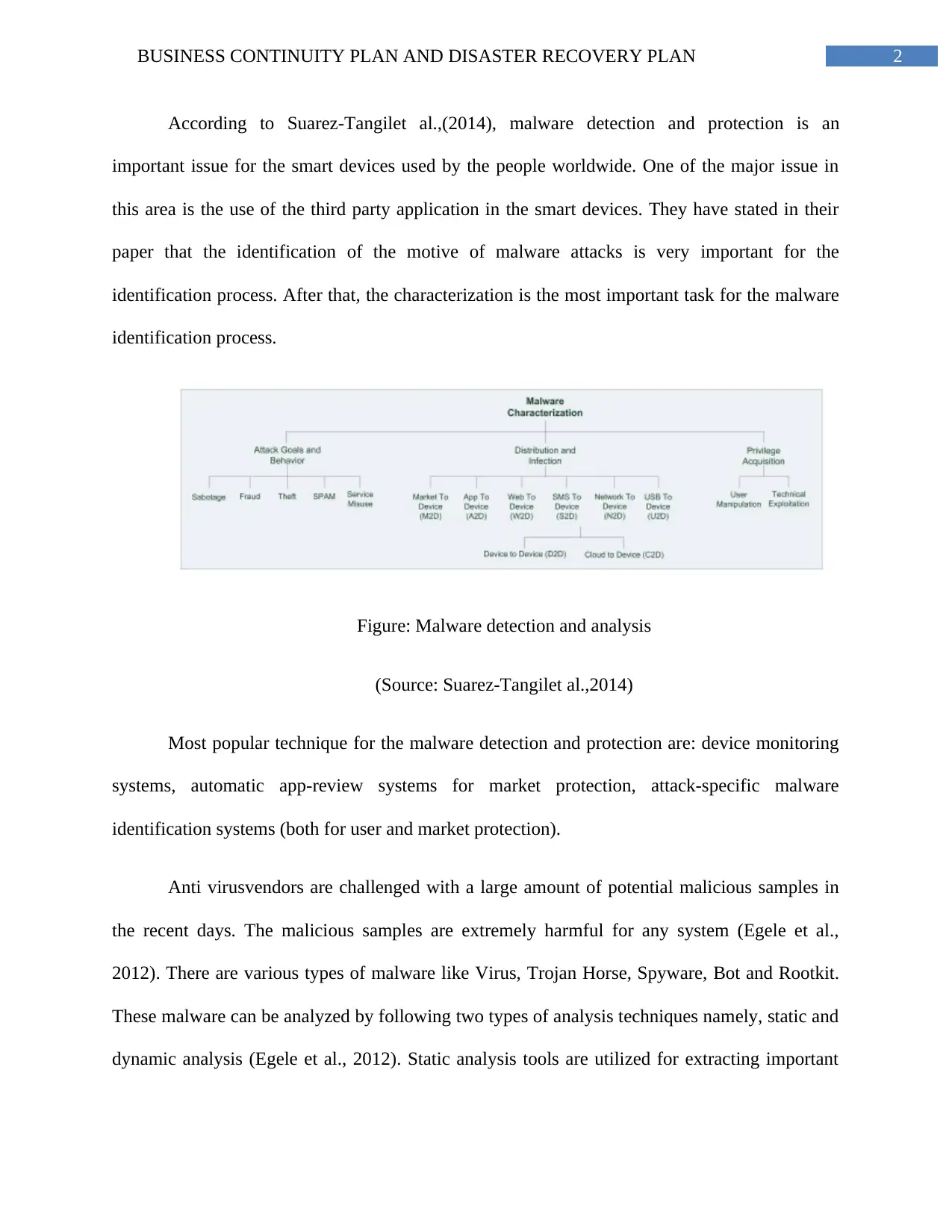
2BUSINESS CONTINUITY PLAN AND DISASTER RECOVERY PLAN
According to Suarez-Tangilet al.,(2014), malware detection and protection is an
important issue for the smart devices used by the people worldwide. One of the major issue in
this area is the use of the third party application in the smart devices. They have stated in their
paper that the identification of the motive of malware attacks is very important for the
identification process. After that, the characterization is the most important task for the malware
identification process.
Figure: Malware detection and analysis
(Source: Suarez-Tangilet al.,2014)
Most popular technique for the malware detection and protection are: device monitoring
systems, automatic app-review systems for market protection, attack-specific malware
identification systems (both for user and market protection).
Anti virusvendors are challenged with a large amount of potential malicious samples in
the recent days. The malicious samples are extremely harmful for any system (Egele et al.,
2012). There are various types of malware like Virus, Trojan Horse, Spyware, Bot and Rootkit.
These malware can be analyzed by following two types of analysis techniques namely, static and
dynamic analysis (Egele et al., 2012). Static analysis tools are utilized for extracting important
According to Suarez-Tangilet al.,(2014), malware detection and protection is an
important issue for the smart devices used by the people worldwide. One of the major issue in
this area is the use of the third party application in the smart devices. They have stated in their
paper that the identification of the motive of malware attacks is very important for the
identification process. After that, the characterization is the most important task for the malware
identification process.
Figure: Malware detection and analysis
(Source: Suarez-Tangilet al.,2014)
Most popular technique for the malware detection and protection are: device monitoring
systems, automatic app-review systems for market protection, attack-specific malware
identification systems (both for user and market protection).
Anti virusvendors are challenged with a large amount of potential malicious samples in
the recent days. The malicious samples are extremely harmful for any system (Egele et al.,
2012). There are various types of malware like Virus, Trojan Horse, Spyware, Bot and Rootkit.
These malware can be analyzed by following two types of analysis techniques namely, static and
dynamic analysis (Egele et al., 2012). Static analysis tools are utilized for extracting important
⊘ This is a preview!⊘
Do you want full access?
Subscribe today to unlock all pages.

Trusted by 1+ million students worldwide
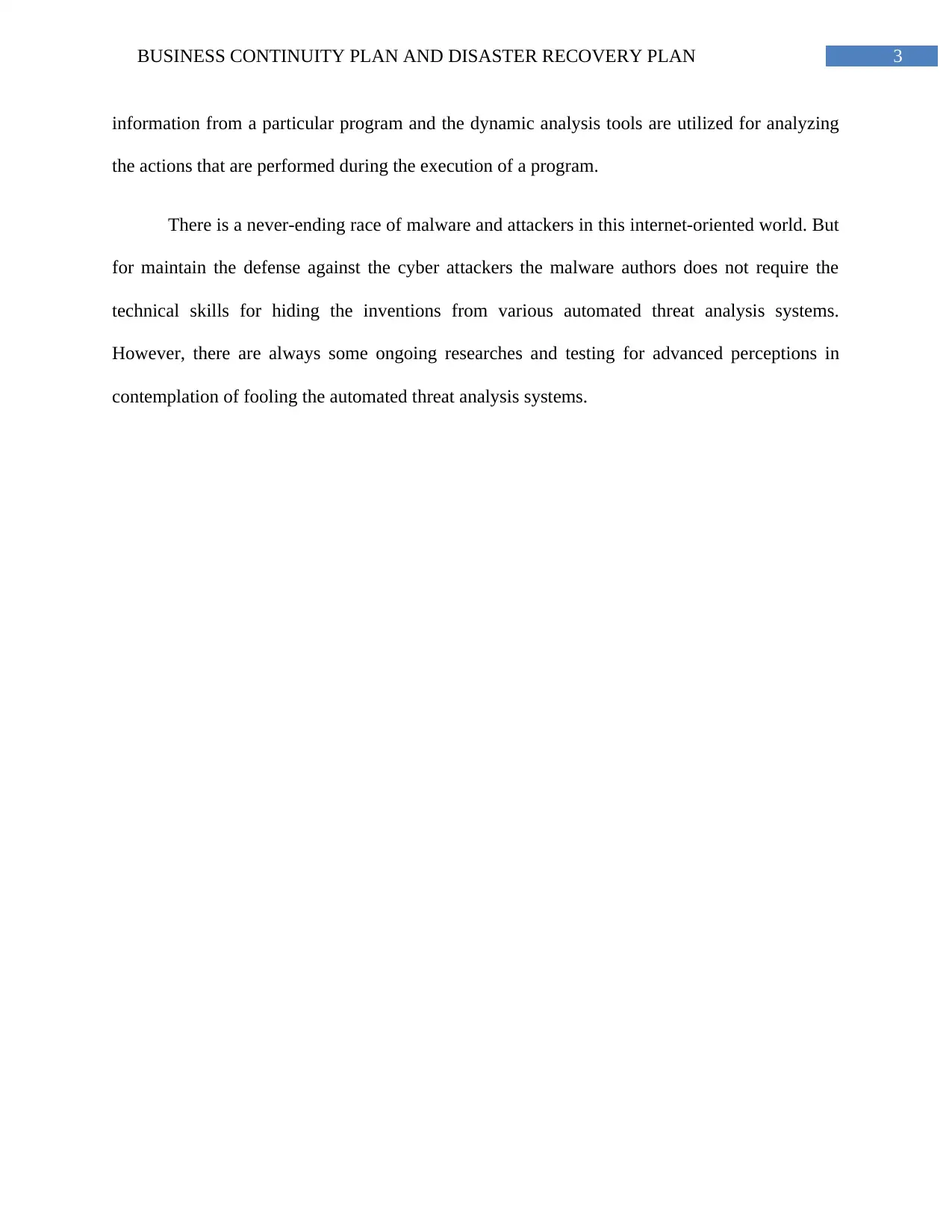
3BUSINESS CONTINUITY PLAN AND DISASTER RECOVERY PLAN
information from a particular program and the dynamic analysis tools are utilized for analyzing
the actions that are performed during the execution of a program.
There is a never-ending race of malware and attackers in this internet-oriented world. But
for maintain the defense against the cyber attackers the malware authors does not require the
technical skills for hiding the inventions from various automated threat analysis systems.
However, there are always some ongoing researches and testing for advanced perceptions in
contemplation of fooling the automated threat analysis systems.
information from a particular program and the dynamic analysis tools are utilized for analyzing
the actions that are performed during the execution of a program.
There is a never-ending race of malware and attackers in this internet-oriented world. But
for maintain the defense against the cyber attackers the malware authors does not require the
technical skills for hiding the inventions from various automated threat analysis systems.
However, there are always some ongoing researches and testing for advanced perceptions in
contemplation of fooling the automated threat analysis systems.
Paraphrase This Document
Need a fresh take? Get an instant paraphrase of this document with our AI Paraphraser
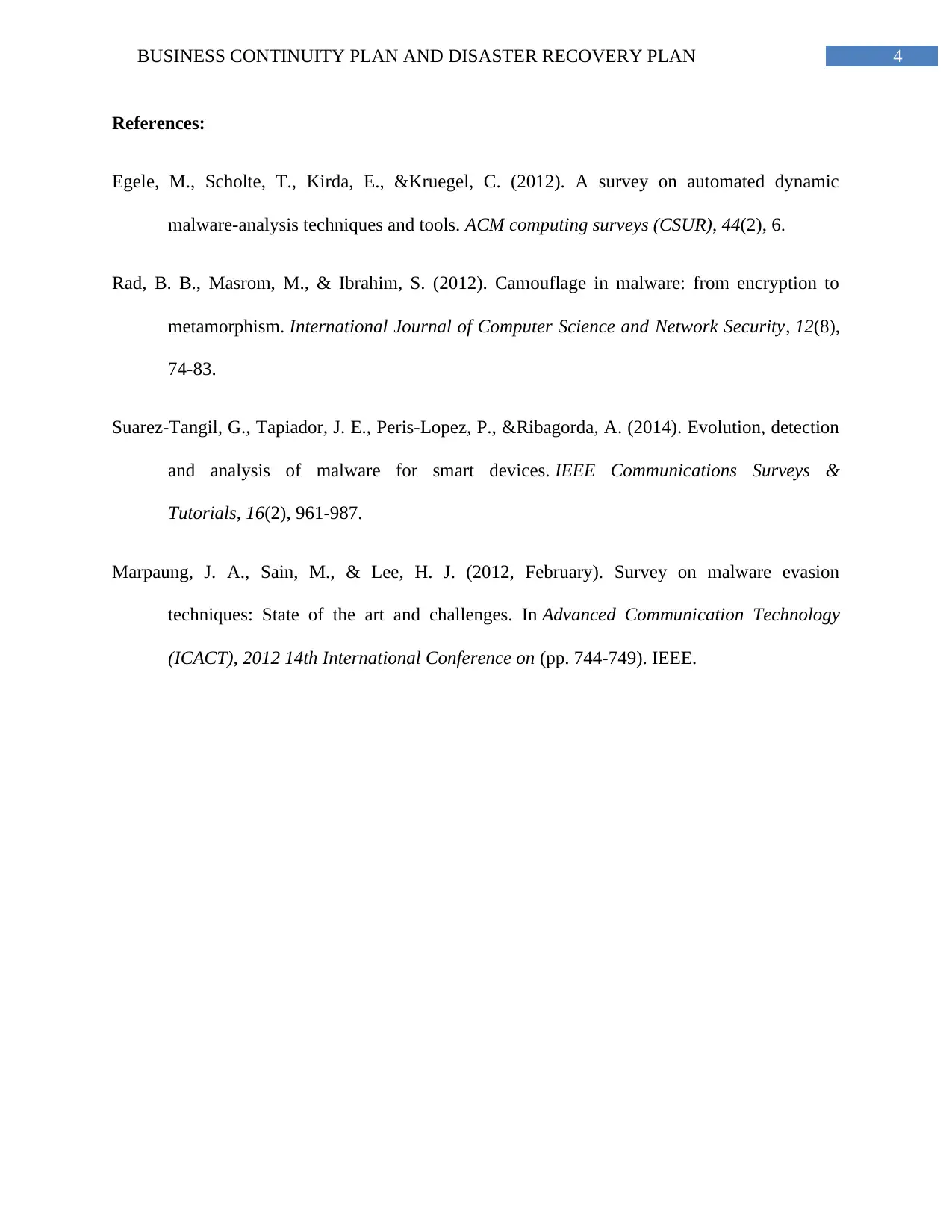
4BUSINESS CONTINUITY PLAN AND DISASTER RECOVERY PLAN
References:
Egele, M., Scholte, T., Kirda, E., &Kruegel, C. (2012). A survey on automated dynamic
malware-analysis techniques and tools. ACM computing surveys (CSUR), 44(2), 6.
Rad, B. B., Masrom, M., & Ibrahim, S. (2012). Camouflage in malware: from encryption to
metamorphism. International Journal of Computer Science and Network Security, 12(8),
74-83.
Suarez-Tangil, G., Tapiador, J. E., Peris-Lopez, P., &Ribagorda, A. (2014). Evolution, detection
and analysis of malware for smart devices. IEEE Communications Surveys &
Tutorials, 16(2), 961-987.
Marpaung, J. A., Sain, M., & Lee, H. J. (2012, February). Survey on malware evasion
techniques: State of the art and challenges. In Advanced Communication Technology
(ICACT), 2012 14th International Conference on (pp. 744-749). IEEE.
References:
Egele, M., Scholte, T., Kirda, E., &Kruegel, C. (2012). A survey on automated dynamic
malware-analysis techniques and tools. ACM computing surveys (CSUR), 44(2), 6.
Rad, B. B., Masrom, M., & Ibrahim, S. (2012). Camouflage in malware: from encryption to
metamorphism. International Journal of Computer Science and Network Security, 12(8),
74-83.
Suarez-Tangil, G., Tapiador, J. E., Peris-Lopez, P., &Ribagorda, A. (2014). Evolution, detection
and analysis of malware for smart devices. IEEE Communications Surveys &
Tutorials, 16(2), 961-987.
Marpaung, J. A., Sain, M., & Lee, H. J. (2012, February). Survey on malware evasion
techniques: State of the art and challenges. In Advanced Communication Technology
(ICACT), 2012 14th International Conference on (pp. 744-749). IEEE.
1 out of 5
Your All-in-One AI-Powered Toolkit for Academic Success.
+13062052269
info@desklib.com
Available 24*7 on WhatsApp / Email
![[object Object]](/_next/static/media/star-bottom.7253800d.svg)
Unlock your academic potential
Copyright © 2020–2025 A2Z Services. All Rights Reserved. Developed and managed by ZUCOL.
